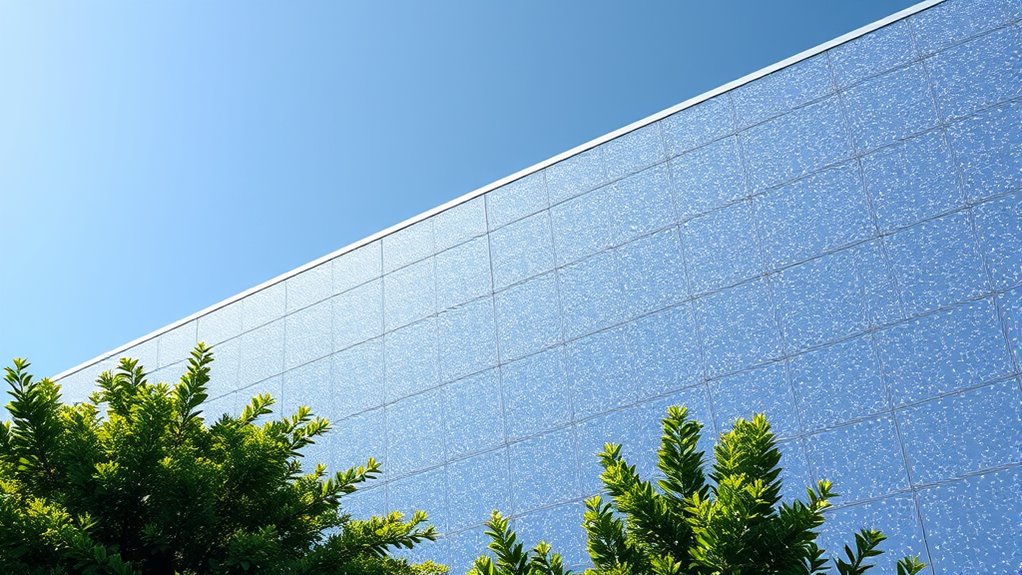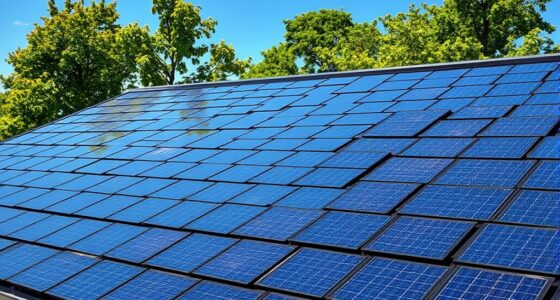Photovoltaic paint enables you to turn building walls into power-generating surfaces by using nanomaterials like quantum dots and perovskites that absorb sunlight beyond traditional panels. These paints are versatile, coatings, and films, designed to capture a broad spectrum of sunlight, including infrared rays. While still developing, advancements aim to make them more efficient, durable, and affordable. Exploring how these innovations work can reveal promising ways to harness urban energy in the future.
Key Takeaways
- Photovoltaic paint can turn building walls into solar energy sources, reducing reliance on traditional rooftop panels.
- It contains light-sensitive particles like quantum dots or perovskites that absorb sunlight and convert it into electricity.
- Emerging technologies enable application as spray-on coatings or thin films, making installation versatile for various surfaces.
- Advances in efficiency and durability are making photovoltaic paint increasingly viable for building-integrated photovoltaics (BIPV).
- Scaling and material stability remain challenges, but ongoing research aims to make power-generating walls practical and cost-effective.
Understanding Photovoltaic Paint and Its Components

Have you ever wondered how photovoltaic paint turns sunlight into electricity? It all starts with photovoltaic paint, a coating embedded with light-sensitive particles like quantum dots or perovskite crystals. These particles are essential semiconductor materials that facilitate energy conversion.
Photovoltaic paint uses light-sensitive particles like quantum dots and perovskite crystals to convert sunlight into electricity seamlessly.
When sunlight hits the paint, these tiny particles absorb a broad spectrum, including infrared rays, boosting efficiency. The paint is often formulated as thin films or spray-on coatings, making it versatile for various surfaces.
Incorporating materials like molybdenum-sulfide or titanium oxide enhances the process, helping convert solar energy into usable electricity. The chemical composition of photovoltaic paint allows it to act as a semiconductor, capturing sunlight and transforming it into electrical energy.
The color accuracy of the paint’s components impacts the overall efficiency of energy conversion. This innovative approach makes power generation more adaptable and integrates seamlessly into different structures.
Exploring the Three Main Types of Solar Paint Technologies

Exploring the three main types of solar paint technologies reveals innovative approaches to harnessing sunlight beyond traditional solar panels. Solar paint includes photovoltaic options like quantum dot solar paint, which uses nanoscale semiconductors that can be tuned to absorb different parts of the light spectrum, boosting efficiency up to 11%. AI-generated music can also be integrated into smart building systems to optimize energy use and comfort. Water-splitting solar paint absorbs water molecules and uses solar energy to split water into hydrogen and oxygen, creating a clean fuel source. The development of renewable energy technologies continues to advance, offering more sustainable options for energy harvesting. Each type offers unique advantages for renewable energy, whether through direct power generation, energy storage, hydrogen production, or flexible applications, expanding the potential of solar energy harvesting beyond conventional panels. Additionally, ongoing research into materials science aims to improve the durability and efficiency of solar paints for long-term use. Incorporating emotional support strategies in research teams can foster collaboration and resilience as scientists work on innovative energy solutions.
Current Progress and Challenges in Developing Solar-Generating Paints

You should recognize that while prototype solar paints have shown promise with efficiencies up to 8%, reaching the 10% threshold is essential for commercial success. Developing stable, cost-effective materials remains a significant hurdle, as current solutions struggle with durability and scalability. Despite steady progress, technical limitations mean widespread adoption is still years away, requiring further innovation and optimization. Additionally, innovations in local sourcing and material sustainability could help reduce costs and improve long-term performance of solar paints. Exploring hackathons such as Hack’n Jill can foster the development of novel solutions by bringing together diverse talents to address these challenges, leveraging curiosity to inspire creative approaches. Advances in sound healing science and sustainable practices could potentially introduce new methods for enhancing material properties or fabrication processes. Recognizing the importance of material stability, ongoing research aims to improve the longevity and resilience of these innovative coatings for real-world applications.
Efficiency Limitations and Gains
Despite significant progress, the efficiency of photovoltaic paint remains limited, typically ranging from 3% to 8%. This falls short of the 10% mark needed for commercial viability, especially compared to silicon panels exceeding 20%. Researchers focus on improving energy conversion through materials like quantum dots and perovskites, which promise higher efficiency. However, current limitations hinder widespread adoption despite the potential for lower costs. Additionally, ongoing research into vertical storage solutions aims to complement these technologies and enhance overall energy management.
Advances aim to boost photovoltaic paint’s role in the renewable energy industry.
Material Development Challenges
Developing photovoltaic paint that balances high efficiency with cost-effectiveness remains a major hurdle for researchers. Achieving better efficiency often involves complex nanomaterials like quantum dots or perovskites, which can be unstable or hard to produce at scale. Baked kale retains essential nutrients and contributes to overall health, highlighting the importance of material stability in maintaining performance. Material development faces challenges in ensuring long-term stability and durability under environmental conditions such as moisture, UV exposure, and weathering. Environmental resistance is critical to maintaining performance over time, but many current formulations fall short. Scalability is another obstacle, as manufacturing processes must be refined to produce consistent, affordable solar paints suitable for widespread application. Improving stability and durability while keeping costs low is essential to advance photovoltaic paint from promising prototypes to practical, commercial solutions capable of powering walls with reliable, long-lasting energy.
Practical Uses and Potential Impact of Power‑Generating Walls

Power-generating walls coated with photovoltaic paint offer a practical way to turn entire building surfaces into solar energy sources, reducing dependence on traditional rooftop panels. These power-generating walls can produce solar energy even in low-light or cloudy conditions, making them a versatile energy solution for various climates. Market trends indicate growing adoption of innovative solar technologies in urban infrastructure projects. Using solar paint on building surfaces lowers installation costs and expands solar access in urban areas where roof space is limited. Integrating photovoltaic paint into building design helps create self-sufficient structures that generate and store renewable energy. This approach considerably increases the surface area available for solar collection, transforming urban landscapes into decentralized power grids. As a result, the solar industry benefits from new applications, and cities move closer to sustainable, renewable energy solutions. Additionally, advancements in energy conversion efficiency are enhancing the viability of these innovative coatings, making them a promising component of future urban planning. Moreover, ongoing research into solar paint durability ensures these coatings can withstand environmental conditions over time, increasing their practical application and long-term effectiveness. The development of materials technology is further contributing to improvements in both performance and longevity of photovoltaic paint.
How to Get Started With Solar Energy Solutions Today

Getting started with solar energy solutions today is straightforward by installing traditional rooftop solar panels through reputable local installers. These systems provide immediate benefits, helping you maximize energy savings and reduce reliance on fossil fuels. The solar panel cost has decreased, and with incentives like the 30% federal tax credit available until 2032, solar power becomes more affordable. While photovoltaic paint is still in development, you can explore options to incorporate solar paint in future upgrades, turning walls and roofs into power sources. Smart technology integration is advancing in solar solutions, offering more efficient and innovative ways to harness energy. Additionally, noise levels of modern heat pumps are now comparable to a refrigerator, making them a quiet and unobtrusive option for home heating and cooling. Platforms like EnergySage allow you to compare quotes and find the best home energy solutions tailored to your needs. Starting now with reliable solar panels ensures you benefit from clean energy and cost savings while staying informed about emerging solar technologies. For example, the industry is also moving toward sustainable cruise port development, which emphasizes environmentally friendly infrastructure to support cruise travelers. Furthermore, understanding Juice Packaging and Storage can help you make informed decisions about sustainable and safe energy-related products. Incorporating regulatory compliance into your planning can help avoid future legal issues and ensure your solar installation adheres to current standards.
The Future Outlook for Power‑Generating Walls and Renewable Energy

Advancements in photovoltaic paint suggest that soon, entire building surfaces—such as walls and roofs—could transform into efficient energy sources. Solar paint, including emerging technologies like perovskite solar cells and quantum dot paints, is nearing commercial viability, promising flexible, power-generating walls.
These innovations will enhance solar energy harvesting, enabling walls to contribute markedly to renewable energy production. Building-integrated photovoltaics will expand beyond rooftops, turning walls and windows into energy sources, potentially reducing reliance on traditional solar panels. Building‑integrated photovoltaics are expected to become more adaptable and cost-effective as research progresses. Moreover, integrating energy storage solutions with photovoltaic systems will maximize energy efficiency and reliability. Developing scalability and performance in these materials remains a key challenge that ongoing research aims to address.
Although current efficiency limitations exist, ongoing research aims to improve performance and scalability. The future of power‑generating walls looks promising, with widespread adoption within the next decade, helping to boost renewable energy output and move toward more sustainable, building-integrated solutions. Hydrogen fuel cells and other renewable energy technologies will likely play a crucial role alongside photovoltaic walls in creating a comprehensive clean energy infrastructure.
Frequently Asked Questions
Does Photovoltaic Paint Exist?
You’re wondering if photovoltaic paint exists. Right now, it doesn’t. Researchers are still developing and testing prototypes with efficiencies between 3% and 8%.
You won’t find any commercial, ready-to-use products on the market today. The technology is still experimental, and scientists are working hard to improve its performance and practicality.
Is Solar Paint Commercially Available?
You might wonder if solar paint is available for purchase. Currently, it’s not commercially available; most of it remains in research and development.
You won’t find solar paint in stores today, as existing versions have low efficiency and are experimental. Researchers are working to improve the technology, but no clear timeline exists for when it will hit the market.
For now, traditional solar panels are your best option for solar energy.
What Paint Collects Solar Energy?
You’re asking about what paint collects solar energy. The answer is photovoltaic paint, which contains light-sensitive nanoparticles that absorb sunlight and convert it into electrical energy.
When applied to surfaces, it captures solar radiation across various light conditions, generating electrons that create electricity. This innovative paint can power devices or contribute to building energy, making it a practical, eco-friendly solution for harnessing solar power directly from walls or surfaces.
How to Make Photovoltaic Paint?
You want to make photovoltaic paint? Imagine mixing tiny, supercharged semiconductors like quantum dots or perovskites into a liquid, turning ordinary walls into solar power farms.
You’ll suspend light-sensitive materials like molybdenum-sulfide or titanium oxide in a brushable medium, then carefully blend binders, solvents, and catalysts.
Apply it to surfaces, let it dry, and voilà—your wall transforms into a lightweight, flexible solar energy generator.
Conclusion
Just like Da Vinci envisioned innovation blending seamlessly with daily life, photovoltaic paint brings solar power into your world. As you explore these power-generating walls, remember the promise of a cleaner, brighter future—one wall at a time. Embrace the potential, take the first step, and become part of the renewable energy revolution. With each new dawn, your walls can become silent generators, turning everyday spaces into sources of sustainable power for generations to come.









